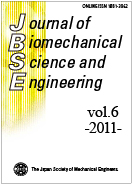All issues

Volume 6 (2011)
- Issue 5 Pages 361-
- Issue 4 Pages 222-
- Issue 3 Pages 134-
- Issue 2 Pages 63-
- Issue 1 Pages 1-
Volume 6, Issue 5
Special Issue on Biomechanics of Human Movement for Medical and Welfare Application
Displaying 1-5 of 5 articles from this issue
- |<
- <
- 1
- >
- >|
Special Issue on Biomechanics of Human Movement for Medical and Welfare Application
-
Tadashi INABA2011Volume 6Issue 5 Pages 361
Published: 2011
Released on J-STAGE: December 28, 2011
JOURNAL FREE ACCESSDownload PDF (112K)
Papers(Special Issue)
-
Tomoyuki NAKAO, Hirokazu MATSUI, Ken'ichi YANO, Naoki KUBOTA, Naruto M ...2011Volume 6Issue 5 Pages 362-377
Published: 2011
Released on J-STAGE: December 28, 2011
JOURNAL FREE ACCESSCreative activities, such as painting and playing instruments, are sources of satisfaction and fulfillment for people with disabilities. However, some individuals with disabilities cannot satisfactorily enjoy such activities because of involuntary movements. In this study, we developed a drawing assist system for users with athetoid cerebral palsy and muscle tension, who experience involuntary movement. To date, assist systems have had difficulty in distinguishing involuntary movement from voluntary movement, and thus we designed a position correction filter to attenuate involuntary movement on the basis of the characteristics of synthesized velocity with respect to involuntary movement. Our system enabled drawing based on the user's own senses and motor control, even when involuntary movement occurred.View full abstractDownload PDF (2818K) -
Ahmad Faizal SALLEH, Ryojun IKEURA, Soichiro HAYAKAWA, Hideki SAWAI2011Volume 6Issue 5 Pages 378-390
Published: 2011
Released on J-STAGE: December 28, 2011
JOURNAL FREE ACCESSA smooth manipulator motion is desired to work cooperatively with human hand in transferring an object. In this article, a relationship between movement time and traveled distance of a cooperative object transfer performed by two humans using their right hands in a seated position was investigated. The relationship will be utilized with a minimum jerk model to generate a smooth cooperative manipulator motion in human-robot cooperative system. The cooperative task was done in leftward/rightward, upward/downward and forward/backward direction relative to the Leader. The results indicated that movement time and traveled distance were positively correlated. The relationship between movement time and traveled distance was represented using a regression line. The difference between Leader's and Follower's relationship was relatively higher in leftward/rightward compared to upward/downward direction. In contrast, in forward/backward direction, both subjects show similar relationship. The difference in relationship between sub-direction, major directions and groups could not be identified. In facilitating the selection of the best relationship for the robot Follower, an average regression line representing all Followers motion in each sub-direction was indentified. In the next phase of the human-robot experiment, all human Leaders from this experiment will be tested with the manipulator motion programmed with the average regression line. Moreover, the parameters of the average regression line will be varied beyond the maximum and minimum values of human Follower's regression line parameters obtained in this experiment.View full abstractDownload PDF (1065K) -
Takamasa YOSHIKAWA, Suguru OI, Yuichi KASAI, Wang ZHUO, Tadashi INABA, ...2011Volume 6Issue 5 Pages 391-398
Published: 2011
Released on J-STAGE: December 28, 2011
JOURNAL FREE ACCESSThe purpose of this study was to investigate the biomechanical stability of unilateral pedicle screw and rod system fixation (unilateral PS fixation) using the Tadpole system fixation for an unstable lumbar spine. We used 5 lumbar spines (L3/4) of a functional spinal unit (FSU) obtained from wild boar cadaver specimens. Damage or instrumentation was sequentially administered to each specimen, and 6 models were prepared: (1) an intact model, (2) an injury model with facet joint resection, (3) a unilateral PS fixation model, (4) a bilateral PS fixation model, (5) a Tadpole system fixation model, and (6) a combination of the unilateral PS and Tadpole system fixation models. We conducted a bending test in 8 directions by using a 6-axis material tester, and the range of motion (ROM) of each model in all directions was measured. The ROM of the combined fixation model of the unilateral PS and Tadpole system was considerably decreased in all directions. These findings indicate that the combination unilateral PS and Tadpole system fixation is a minimally invasive method that has the same stability as bilateral PS fixation.View full abstractDownload PDF (1803K) -
S. M. Mizanoor RAHMAN, Ryojun IKEURA, Soichiro HAYAKAWA, Haoyong YU2011Volume 6Issue 5 Pages 399-414
Published: 2011
Released on J-STAGE: December 28, 2011
JOURNAL FREE ACCESSThis paper investigates human characteristics in terms of weight perception, load forces, motions etc. for manipulating objects with a power assist robot and proposes a novel control for the robot based on the human characteristics to improve maneuverability, safety etc. We hypothesized that weight perception due to inertia might be different from that due to gravity for manipulating objects with power-assist. A 1-DOF power assist robot was developed and simulated. Subjects manipulated objects with the robot for two types of motions: (i) linear vertical (lifting objects vertically), (ii) harmonic (objects repeatedly lifted up and lowered down).We analyzed weight perception, load forces and motions. We then introduced a novel control strategy, which was such that a virtual mass exponentially declined from a large value to a small one when the subjects manipulated the objects with the robot and the command velocity exceeded a threshold. The novel control reduced excessive load forces and accelerations and improved maneuverability, safety etc. We compared the results for linear motion to that for harmonic motion. We also demonstrated the conditions to further optimize the performances. Finally, we proposed using the findings to develop human-friendly power assist devices to manipulate heavy objects in industries that would improve productivity, worker's health and wellness. We also argued that the weight perceptual and psychophysical criteria used to control the robot would satisfy the biomechanical criteria of robot operator manipulating heavy objects, and thus we attempted to establish a trade-off between psychophysical and biomechanical criteria for manipulating objects with power-assist.View full abstractDownload PDF (722K)
- |<
- <
- 1
- >
- >|